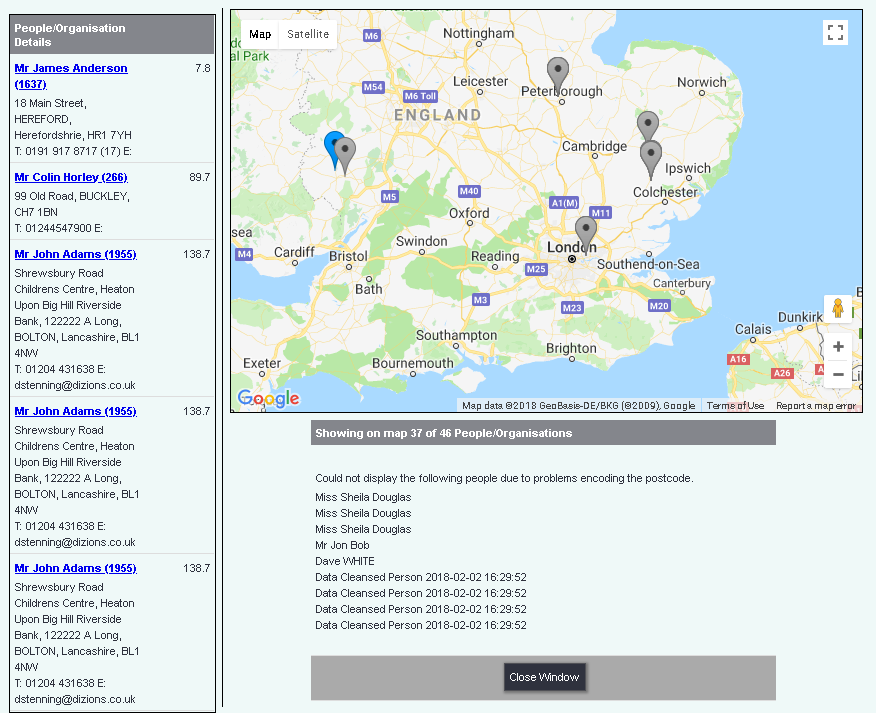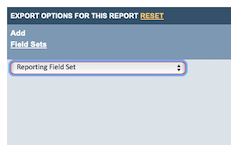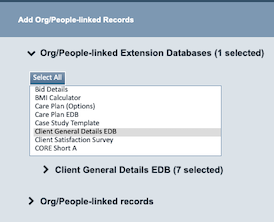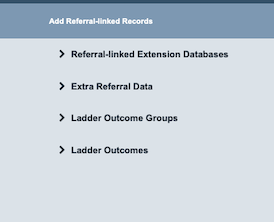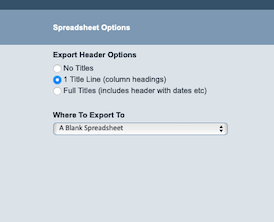Blue Folder Lookup
Contents
Introduction
The Blue Folder Lookup page allows you to see the details behind that make up the numbers on a report. For example, if you ask for "number of contacts" using the KPI Report Designer, you will get a total number of contacts; next to the number is a blue folder, which will allow you to see the full details of the contacts counted towards that number. The webinar explains its key functions and additional information is below.
In the blue folder you are able to do the following:
- Mail Merge - This process will allow sending emails, letters from the system to the people/organisations. You can do this via Charitylog using the Preview Mail Merge function or Generate Spreadsheet and export the data into a third party system.
- Map View - Se the location of the people/organisations on a map.
- Extract the data - You are able to extract the data into a spreadsheet for analysis. The extraction can include:
- Additional fields from the person/organisation record.
- Additional information linked to the record, like benefits, disabilities, project record, extension databases (bespoke fields) and more.
- Additional information about the referrals (referral based KPI's), including assessments, extension databases and outcome.
- Use spread sheet templates that can be used for built in analysis for other members of staff.
- Print - Print the summary details that make up the KPI.
The Blue Folder page is split up into three sections:
- Export Options for the Organisations and People in this Report This will export the details based on individuals or organisations to either a mail merge or map. If a person/organisation appears multiple times in the report they will only be exported as one person/organisation.
- Export options for this report - Allows the Report Data to be exported with additional information for analysis.
- The report data - Summary details of the report data.
Export Options for the Organisations and People in this Report
This section will export the details based on individuals or organisations to either a mail merge or map. If a person/organisation appears multiple times in the report they will only be exported as one person/organisation. There are two facilities:
Mail Merge
The mail merge option is powered by Mail Merge Formats which allow the records to either:
- Produce a letter - This will allow the printing of multiple letters to the recipients.
- Produce an Email - This will allow the batch of multiple letters to the recipients. It would be recommended to send no more than 300 (use extra criteria on Mail Merge Formats to filter recipients) at a time and to use your own Email Server.
- Text Messages - Allows bulk texts to be sent using the TextAnywhere service.
- 3rd Party Mail Merge - The system will produce a spread sheet to use with other systems like Mail Chimp or MS Word.
To configure a new Mail Merge Format click on the link 'Mail Merge Format', you will need to re-run the report. If you open up the Mail Merge Format in a new tab you will need to refresh press F5 on the keyboard) the Blue Folder page once its set up.
NOTE : Choosing a mail merge format will not apply any extra criteria set up in in the mail merge format. The only further filtering it will do is via the consent options.
Select the mail merge format you wish to use and click the 'Confirm Mail Merge' button. Depending on the type of format selected you will then be taken through the next steps:
Export to Spreadsheet
Depending on your internet browser you will be prompted to open or save the spread sheet.
Generate letters and emails
Generating SMS (text messages)
You will be displayed a list of recipients. By default any record that has the Mobile Telephone Number completed on will display this number (you can use a different number via the drop down), otherwise there will be a drop down to select the appropriate number. If the persons name is crossed out with a warning triangle then there is no numbers available on the record. If you wish to exclude a person then select none in the drop down menu.
At the bottom of the lest you will find the message box to enter the details of the message. There is also a counter to show how many characters have been entered and how text messages that are needed to send the message. Most modern phones will relieve the messages as if it was one message. Once completed click the 'Send SMS' button to send, or 'Cancel' to return to the report. When you click send you will receive a message informing you how many TextAnywhere credits will be used, click 'OK to send or 'Cancel'. Once send you will then receive the results.
Map View
The Map View will pin point the location of each person/organisation on the map. On the left hand side you will find a list of people/organisations that appear on the map, and below the mapp you will find details of records that are not on the map as they do not have a correct postal code.
On the map you can click a map pin to view the details of the person/organisation and click again to hide the details. You are able to zoom in if required and a full screen option is available. If you want to take a copy you can either take a screen shot or use a snipping tool.
Click the 'Close Window' button to return to the report data.
Export Options
The export options allow extraction of the data with the ability of adding additional information for analysis in applications like MS Excel. This section is broken down into four columns:
Field Sets
Field Sets specify additional fields from the persons/organisations record. When you select a field set this information will be added to the report data and exported to a spread sheet. The folwing fields can be used:
- System ID Number - Auto populated when a record is created.
- Name - An individuals surname or an organisations name, depending on the record type.
- Forename(s) - A person first and middle names
- Initials - Auto populated from the forenames field
- Title - The persons title, Mr, Master, Miss, Mrs, Ms, Dr, Rev etc.
- Salutation - Auto populated using the 'Title' and 'Name' fields.
- Address line 1 - House number/Name and Street
- Address line 2 - Flat/Block or Apartment #
- Address line 3 - Village/Locality
- Address line 4 (Town) - Town
- Address line 5 (County) - County
- Postcode - - Postcode
- Postal District - District (Often used for Local Authority Areas). Generally used for reporting on work done in these areas.
- Preferred Method of Communication - How this person/organisation would normally be contacted.
- Main Telephone No. - Main telephone number to contact the person/organisation.
- Mobile Telephone No. - Mobile Phone number.
- Emergency Telephone No. - Emergency contact number, recommended you put who's number this is in brackets - example 01234 567890 (Mother).
- Email Address (Main) - The main Email address.
- Notes / General Description - Used for basic notes, used to explain details about telephone numbers or other things about the person/organisation. Not to be used for case/referral notes.
- Consent Given - If this person has given consent to be recorded, this has been superseded by Consent Rules
- Active - This determines if this record is available to the normal searches. If a record is inactive it is not destroyed and can easily be made active again.
- Gender - The legal gender of an individual.
- Date of Birth - This field displays day, month and year of birth.
- Age Range - Auto calculated using the date of birth.
- Marital Status - A person marital status.
- Sexual Orientation - A person sexual orientation/preference
- Ethnic Group - An ethnic group, or an ethnicity, is a category of people who identify with each other based on similarities such as common ancestry, language, history, society, culture or nation.
- Religious Group - An individuals personal religious beliefs.
- Victim of Crime - Is this person currently a victim of crime generally used in relation to the Domestic Violence, Crime and Victims Act 2004
- Employed? - The employment status of an individual.
- Blue Badge Holder? - Does this person have a blue badge (The Blue Badge scheme helps you park closer to your destination if you’re disabled).
- GP Surgery - A persons GP Surgery, this is populated using the field 'Is this a GP Surgery?' used on an organisations record type.
- GP Name - A person GP (Doctor), this is populated using the field 'Is this a GP (Doctor)?' used on a professionals record.
- Accounts Code - This is used by the invoice module and often is the accounts code from an accounts program.
- Status - On a carer system this is used for the types of carers, other organisations may use this to say an individuals status.
- NI Number - A persons National Insurance number.
- NHS Number - A person National Health Service (NHS) Number.
- Social Services ID No. - A persons reference number with the local authorities social services. This is often called a different name depending on the local authority.
- Living Arrangements - An individuals living arrangements - Lives alone, with partner/spouse etc.
- People in Household - A fixed field to record the number of people living in a household.
- Accommodation Type - The type of accommodation a person is living in - House (Private), House (Social Housing), Care Home etc.
- Any Disabilities? - Does this person have any disabilities. This field can be set manually or is automatically updated when a main disability is recorded.
- Registered Disabled? - Is this person registered on a local authorities voluntary system or used for Registered Blind.
- Main Disability - A a persons primary disability, this will auto populate the 'Any Disabilities?' if you disable this feature it is also recommended that you change the Operational Rules to disable the requirement of main disability.
- General Category of Need - This is used to classify a persons need level. A person can only be in one category at a time.
- Deceased? - Specifies if the person has died and will activate termination process.
- Risk Assessment - This is a text box that allows risk assessment information to be recorded. When populated it the tab label will change to '***Risk Assessment***' and a warning symbol will be displayed on search pages and the Action List.
- Job Title - A person job title
- Image or logo - Used to attach a photo of an individual or a logo of an organisation to be displayed on the record.
- Department - A persons department that they work in.
- Is this a Young Carer? - Used on a carers system to specify the individual is a young carer. This is also auto populated from the 'Status' field.
- Email Address (Other) - A secondary Email address
- School - What school a person attends/works in/manages. This is auto populated by the 'Is this a school field'
- Person/Organisation Category - A way of categorising organisation and professionals. Example: If you add several Social Services teams on the system they could all be categorised as 'Social Services' which can then be reported on by category.
- Website - The website address for an organisation.
- Social Media Link 1 - A box to enter a social media link.
- Preferred Known As - A box to specify a person preferred name
- Induction Date - A workers/volunteers induction date.
- Service User Group - Some organisation categorise their service users into groups, a person can only be in one group.
- First Referral Date - The date a person was first referred. This is auto populated from the first referral recorded on the system. You can change the
- Social Media Link 2 - A box to enter a social media link.
- UDPRN (Royal Mail) - Unique Delivery Point Reference Number.
- ID Badge Number - A person ID badge number.
- Eligible For Gift Aid? - Used if a person has completed a Gift Aid Certificate.
- References Taken? - Used for personnel records.
- Social Media Link 3 - A box to enter a social media link.
- Main Language - A persons main spoken language.
- Landline Telephone No. - Land-line (home) telephone number.
- Fax/Other Telephone No. - Used for either a fax or additional number.
- Current School Year - This is auto populated from the data of birth and school year offset.
- User Name: ##LINK_NAME## - This is a system users user name, usually displayed on staff and volunteer records.
- Payment Method - Specifies a persons payment method, if the invoice module is used it will also update the footer on invoices.
- DBS/PVG Checked? - Disclosure Barring Service (England or Wales) or Protecting Vulnerable Groups (Scotland) check has been carried out.
- PAYE Reference - A persons Pay As You Earn tax reference service.
- Second Referrer/Contact - Specify a secondary referrer that often refers the person.
- DBS/PVG Expiry Date? - Expiry date as determined by your organisations own policies.
- Is this a GP (Doctor)? - Used for professionals which populates the GP/Doctor list used on client records.
- UTR Number - Unique Tax Reference number which is usually used for self employed people.
- Is this a GP Surgery? - Used for refers and organisations, this will populate the GP surgery list used on client records.
- Is this a School? - Used on organisations to populate the Schools list used on Client/Student records.
- PIN (for CM System) - PIN number used with CM integrations.
- Is this a Handyperson? - Used to specify that the record is a Handy Person and can be allocated jobs in the HandyPerson Module.
- Is this an Org/Signpostee? - This field will set any record type as an 'Organisation' type record as well. This field should not be added to an 'Organisation' record it will lose it's record type.
- Main Referrer/Contact - The main referrer for the person. This field can auto populate the Record A Contact screen's Referrers field, see Operational Rules for further details.
- Is this a Referrer? - This field will set any record type as a 'Referrer' type record as well. This field should not be added to a 'Referrer' record it will lose it's record type.
- Is this a Carer? - Used on a non carer system. This will make a client record a carer record as well.
- Usual Support Worker - This is a list of Staff and Volunteers on the system.
- DBS/PVG Issued Date? - The date that a DBS/PVG certificate was issued.
- Is this a Supplier? - Marks the record as a supplier record as well.
- Include in Info. Links - Allows the record to have the 'Save and Set Information Links' button at the base of the record. This will put the record on the Information Links directory.
- School Year Offset - Allows the School Year to be adjusted with the relevant offset.
- Nourish Carer ID - Used with the Nourish Integration.
- Nourish Carer Username - Used with the Nourish Integration.
- DBS/PVG Certificate Number - DBS/PVG Certificate Number
- Ezitracker ID - Used with Ezitracker dial in system.
- Nourish Carer API Key - Used with the Nourish Integration.
- Webroster ID - Deprecated Feature
- Alternative Identifier - ID number to much to a secondary system that you may use.
Add Org/People-linked Records
You are able to include multiple options from the Org/People linked records, use the CTRL on the keyboard to make the selections. The available linked records can be selected:
Extension Database
Extension Databases are groups of bespoke fields that can be added to a records tabs or displayed on the footer of the record. All available Extension Databases will be displayed, this is determined by the type and security of the Extension Database.
Other org/people-linked records
This section of the list will allow you to attach the following:
- Benefit Details - Details of the benefits recorded via the blue link of a record or on the referral outcomes page. This will include all benefits.
- Benefit Values - Values of the benefits recorded via the blue link of a record or on the referral outcomes page. This will include all benefits.
- Club and Clinic Attendances - Details of Clubs and Clinic attendances for the person/organisation.
- Club and Clinic Memberships - Columns for all Clubs and Clinics with a Y for each Club/Clinic the person/organisation is a member of.
- Consent Options - Details of the Consent Rules recorded on the records.
- Courses and Qualifications - Details of any courses or qualifications (blue links at the base of the record) that are recorded.
- Groups and Skills - Which groups and skill have been added via the bl;ue link on the footer of the record.
- Full Disability Records - Columns for disabilities with a Y for each disability record on the person's/organisation's record.
- In Project Records - Columns for each project with a Y for each project the person/organisation is in or been in.
- NoK and Contacts - Details of the Next of Kins and Contacts recorded using the blue link at the footer of the record.
- Output Areas and Wards - If LSOA Areas and Wards data has been populated and matched with the post code this will be added to the report data.
- Relationships - Attaches the relationship type and the related persons name.
- Relationships (Full details) - Attaches the relationship type and the related persons full details (Name, Contact details and other key fields).
- Carer Relationships - Attaches the carer relationship type and the carers name.
- Carer Relationships (Full details) - Attaches the carers relationship type and the carers full details (Name, Contact details and other key fields).
- Dependant Relationships - Attaches the Cared Fors relationship type and the Cared Fors name (only available on a carer system).
- Dependant Relationships (Full details) - Attaches the Cared Fors relationship type and the Cared Fors full details (Name, Contact details and other key fields) (only available on a carer system).
- Associated People - Attaches the names of associated people to an organisation, this is from the blue link on the footer of an organisation based record type.
- Associated Organisations - Attaches the names of associated organisation to a person, this is from the blue link on the footer of an person based record type.
Multiple selections can be made by holding down the CTRL button on the keyboard. If you select relationships you will be displayed the option to add additional data to those records as well.
Add Referral-linked Records
Assessment Forms (Deprecated Feature)
The answers to each question on the assessment forms selected.
Assessment Scores (Deprecated Feature)
The scores to each question and section on the assessment forms selected.
Extension Databases
Extension Databases are groups of bespoke fields that can be added to a referral. All available Extension Databases will be displayed, this is determined by the type and security of the Extension Database. When you select an Extension database you will then be able to choose which fields you want to add to your extract. This means you can select relevant fields rather than the entire extension database.
Extra Referral Data
Referral link records are only available when reporting on referrals or contacts. Project and person based reports will not show any referral based options. The follow options can be included on the export:
- Extra Referral Data - This will include additional details about the referral.
- Benefit Details - Details of the benefits recorded via the blue link of a record or on the referral outcomes page. This will include only the benefits attached to the referrals linked to the report data.
- Benefit Values - Values of the benefits recorded via the blue link of a record or on the referral outcomes page. This will include only benefit values attached to the referrals linked to the report data.
- Referral Reasons - This will produce a column for each referral reasons and place a Y under the reasons selected on the referral.
- Conflict of Interest - This will include all Conflict of Interests that have been recorded to any referral linked to the report data.
Multiple selections can be made by holding down the CTRL button on the keyboard.
On all of the above it does need consideration to the amount of additional options chosen. If you select too many options this may cause your internet browser to time out or your machine to crash if the spread sheet is too big for the specification of your machine or software.
Spreadsheet Options
Options in this section affect the output of the spread sheet that is exported.
- Export Header Options
- No Titles - just the report and options data, no field titles will be included.
- 1 Title Line (column headings) - The report and options data including field names as headers.
- Full Titles (includes header with dates etc) - Details of the report plus the report and options data including field names as headers.
- Where To Export To
- A blank spreadsheet - the data will appear on a newly created spreadsheet.
- Uploaded Spreadsheet - You will see a list of spreadsheet templates uploaded via System Uploads. The data will be placed on the worksheet specified by the template.
When you have specified your criteria the spreadsheet will be prepared and presented to open or save (depending on your browser).
Report Data
At the bottom of the Blu Folder Lookup page you will see the report data. If you wish to print this click on the 'Print Report' button.
When you have finished click on the 'Close Report' Button

